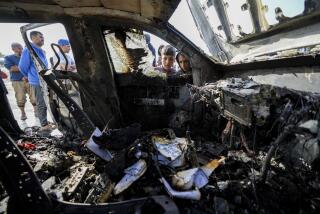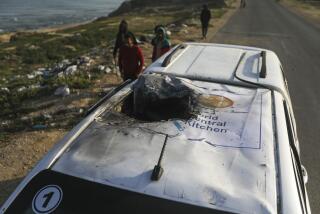Egypt report depicts violence that killed 846
A new Egyptian government investigation into the nearly-three-week revolution that overthrew President Hosni Mubarak in February paints a sinister portrait of a desperate police state relying on snipers, thugs and other forces that led to the deaths of at least 846 people.
The lead judge on the fact-finding commission said Tuesday that Mubarak was at least indirectly responsible for the deaths of hundreds of protesters at the hands of police officers and Interior Ministry agents. The study was released days after the 82-year-old former leader was held for questioning in the killings and concerning wider corruption during his nearly 30 years in power.
“What is confirmed is that Mubarak’s permission” was needed for such a response, said Judge Omar Marwan. “The shooting lasted for several days, and he did not interfere to stop it or hold accountable those who fired live rounds.”
He added: “This confirmed his involvement in responsibility.”
The estimate of at least 846 people killed between Jan. 25 and Feb. 11 is more than double the figure given in earlier government statements. The report underscores the breadth of violence, including snipers firing from rooftops and thugs wielding sticks, of a police state struggling to outflank a determined protest movement. The findings epitomize the Mubarak regime’s entrenched brutality in crushing opposition voices.
“The fatal shots were due to firing bullets at the head and the chest,” states the report, compiled by a panel of judges and based on 800 video clips and interviews with more than 17,000 government officials and witnesses. More than 6,400 people were injured, including those who were intentionally run over by police vehicles.
The commission found that police officers and snipers from anti-terrorism units attached to the Interior Ministry fired live ammunition and rubber bullets. The report concludes that former Interior Minister Habib Adly, who is facing trial on financial corruption charges, was responsible for ordering the shootings.
The judges said the high number of deaths and injuries nationwide pointed up police officers’ having used excessive force against demonstrators who were careful to “show the peaceful nature of their protests through their chants, especially in Tahrir Square from Jan. 25 until Jan. 28. However, police responded by firing water cannons against protesters and when police weren’t successful in dispersing protesters, they started firing rubber bullets and live gunshots.”
Such scenes, including bystanders shot while watching protests from their balconies, played out daily during a revolution that jolted the Arab world and inspired other revolts across North Africa and the Middle East. The toppling of Mubarak led to the arrest of a number of Cabinet officials, businesspeople and others within the former leader’s inner circle, including his two sons, Gamal and Alaa.
The transitional government headed by a military council had said for weeks that the death toll during the protests was 384. Critics and witnesses repeatedly challenged that figure. The commission’s report states that the new estimate of 846, which includes 26 police officers, some of whom were attacked by protesters, was arrived at after discrepancies were noted in two investigations done by the Health Ministry.
The panel said that pro-Mubarak demonstrators who started what became known as “Bloody Wednesday,” the Feb. 2 rampage against anti-government protesters in Tahrir Square, were organized by the former ruling National Democratic Party. Supporters of Mubarak stormed the square, hurling stones and Molotov cocktails while police fired rubber bullets and tear gas in attempts to disperse anti-government marchers.
The attack bordered on the medieval when riders on camels and horses galloped into the crowd. The report said the riders were police officers and NDP members.
Mubarak has been in a hospital in the Red Sea resort of Sharm el Sheik since suffering heart problems last week during interrogation by prosecutors. When his condition improves, he is expected to be taken to a military hospital, where he will be held for more questioning.
Fleishman reported from Manama and news assistant Hassan from Cairo.
More to Read
Start your day right
Sign up for Essential California for news, features and recommendations from the L.A. Times and beyond in your inbox six days a week.
You may occasionally receive promotional content from the Los Angeles Times.







